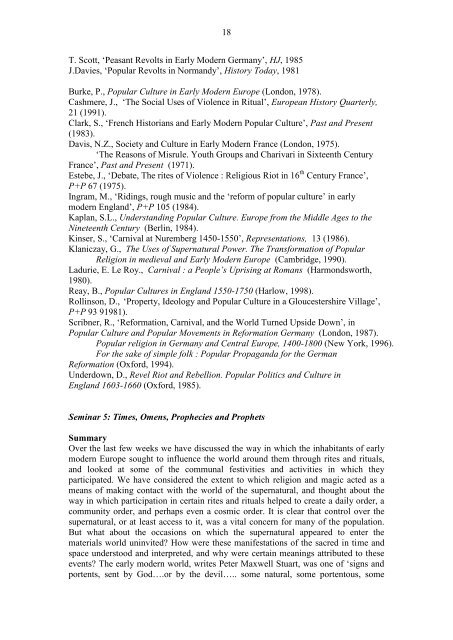Ritual, Myth and Magic in Early Modern Europe - University of Reading
Ritual, Myth and Magic in Early Modern Europe - University of Reading
Ritual, Myth and Magic in Early Modern Europe - University of Reading
You also want an ePaper? Increase the reach of your titles
YUMPU automatically turns print PDFs into web optimized ePapers that Google loves.
18<br />
T. Scott, ‗Peasant Revolts <strong>in</strong> <strong>Early</strong> <strong>Modern</strong> Germany‘, HJ, 1985<br />
J.Davies, ‗Popular Revolts <strong>in</strong> Norm<strong>and</strong>y‘, History Today, 1981<br />
Burke, P., Popular Culture <strong>in</strong> <strong>Early</strong> <strong>Modern</strong> <strong>Europe</strong> (London, 1978).<br />
Cashmere, J., ‗The Social Uses <strong>of</strong> Violence <strong>in</strong> <strong>Ritual</strong>‘, <strong>Europe</strong>an History Quarterly,<br />
21 (1991).<br />
Clark, S., ‗French Historians <strong>and</strong> <strong>Early</strong> <strong>Modern</strong> Popular Culture‘, Past <strong>and</strong> Present<br />
(1983).<br />
Davis, N.Z., Society <strong>and</strong> Culture <strong>in</strong> <strong>Early</strong> <strong>Modern</strong> France (London, 1975).<br />
‗The Reasons <strong>of</strong> Misrule. Youth Groups <strong>and</strong> Charivari <strong>in</strong> Sixteenth Century<br />
France‘, Past <strong>and</strong> Present (1971).<br />
Estebe, J., ‗Debate, The rites <strong>of</strong> Violence : Religious Riot <strong>in</strong> 16 th Century France‘,<br />
P+P 67 (1975).<br />
Ingram, M., ‗Rid<strong>in</strong>gs, rough music <strong>and</strong> the ‗reform <strong>of</strong> popular culture‘ <strong>in</strong> early<br />
modern Engl<strong>and</strong>‘, P+P 105 (1984).<br />
Kaplan, S.L., Underst<strong>and</strong><strong>in</strong>g Popular Culture. <strong>Europe</strong> from the Middle Ages to the<br />
N<strong>in</strong>eteenth Century (Berl<strong>in</strong>, 1984).<br />
K<strong>in</strong>ser, S., ‗Carnival at Nuremberg 1450-1550‘, Representations, 13 (1986).<br />
Klaniczay, G., The Uses <strong>of</strong> Supernatural Power. The Transformation <strong>of</strong> Popular<br />
Religion <strong>in</strong> medieval <strong>and</strong> <strong>Early</strong> <strong>Modern</strong> <strong>Europe</strong> (Cambridge, 1990).<br />
Ladurie, E. Le Roy., Carnival : a People’s Upris<strong>in</strong>g at Romans (Harmondsworth,<br />
1980).<br />
Reay, B., Popular Cultures <strong>in</strong> Engl<strong>and</strong> 1550-1750 (Harlow, 1998).<br />
Roll<strong>in</strong>son, D., ‗Property, Ideology <strong>and</strong> Popular Culture <strong>in</strong> a Gloucestershire Village‘,<br />
P+P 93 91981).<br />
Scribner, R., ‗Reformation, Carnival, <strong>and</strong> the World Turned Upside Down‘, <strong>in</strong><br />
Popular Culture <strong>and</strong> Popular Movements <strong>in</strong> Reformation Germany (London, 1987).<br />
Popular religion <strong>in</strong> Germany <strong>and</strong> Central <strong>Europe</strong>, 1400-1800 (New York, 1996).<br />
For the sake <strong>of</strong> simple folk : Popular Propag<strong>and</strong>a for the German<br />
Reformation (Oxford, 1994).<br />
Underdown, D., Revel Riot <strong>and</strong> Rebellion. Popular Politics <strong>and</strong> Culture <strong>in</strong><br />
Engl<strong>and</strong> 1603-1660 (Oxford, 1985).<br />
Sem<strong>in</strong>ar 5: Times, Omens, Prophecies <strong>and</strong> Prophets<br />
Summary<br />
Over the last few weeks we have discussed the way <strong>in</strong> which the <strong>in</strong>habitants <strong>of</strong> early<br />
modern <strong>Europe</strong> sought to <strong>in</strong>fluence the world around them through rites <strong>and</strong> rituals,<br />
<strong>and</strong> looked at some <strong>of</strong> the communal festivities <strong>and</strong> activities <strong>in</strong> which they<br />
participated. We have considered the extent to which religion <strong>and</strong> magic acted as a<br />
means <strong>of</strong> mak<strong>in</strong>g contact with the world <strong>of</strong> the supernatural, <strong>and</strong> thought about the<br />
way <strong>in</strong> which participation <strong>in</strong> certa<strong>in</strong> rites <strong>and</strong> rituals helped to create a daily order, a<br />
community order, <strong>and</strong> perhaps even a cosmic order. It is clear that control over the<br />
supernatural, or at least access to it, was a vital concern for many <strong>of</strong> the population.<br />
But what about the occasions on which the supernatural appeared to enter the<br />
materials world un<strong>in</strong>vited? How were these manifestations <strong>of</strong> the sacred <strong>in</strong> time <strong>and</strong><br />
space understood <strong>and</strong> <strong>in</strong>terpreted, <strong>and</strong> why were certa<strong>in</strong> mean<strong>in</strong>gs attributed to these<br />
events? The early modern world, writes Peter Maxwell Stuart, was one <strong>of</strong> ‗signs <strong>and</strong><br />
portents, sent by God….or by the devil….. some natural, some portentous, some

















